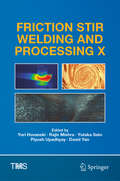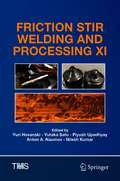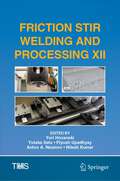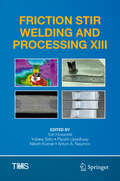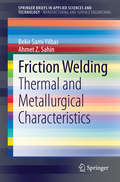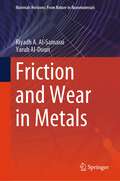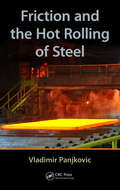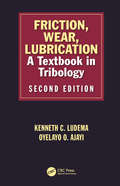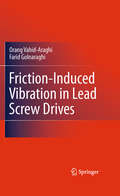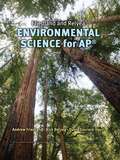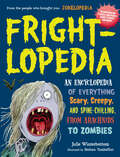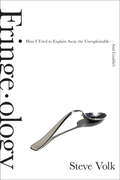- Table View
- List View
Friction Stir Welding and Processing X (The Minerals, Metals & Materials Series)
by Yuri Hovanski Rajiv Mishra Yutaka Sato Piyush Upadhyay David YanThis book is a compilation of the recent progress on friction stir technologies including high-temperature applications, industrial applications, dissimilar alloy/materials, lightweight alloys, simulation, control, characterization, and derivative technologies. The volume offers a current look at friction stir welding technology from application to characterization and from modeling to R&D. Contributions document advances in application, controls, and simulation of the friction stir process to aid researchers in seeing the current state-of-the-art.
Friction Stir Welding and Processing XI (The Minerals, Metals & Materials Series)
by Nilesh Kumar Yuri Hovanski Yutaka Sato Piyush Upadhyay Anton A. NaumovThis collection presents fundamentals and the current status of friction stir welding (FSW) and solid-state friction stir processing of materials, and provides researchers and engineers with an opportunity to review the current status of the friction stir related processes and discuss the future possibilities. Contributions cover various aspects of friction stir welding and processing including their derivative technologies. Topics include but are not limited to: • derivative technologies • high-temperature lightweight applications • industrial applications • dissimilar alloys and/or materials • controls and nondestructive examination • simulation • characterization
Friction Stir Welding and Processing XII (The Minerals, Metals & Materials Series)
by Nilesh Kumar Yuri Hovanski Yutaka Sato Piyush Upadhyay Anton A. NaumovThis collection presents fundamentals and the current status of friction stir welding (FSW) and solid-state friction stir processing of materials and provides researchers and engineers with an opportunity to review the current status of the friction stir related processes and discuss the future possibilities. Contributions cover various aspects of friction stir welding and processing including their derivative technologies. Topics include, but are not limited to:• Derivative technologies • High-temperature applications • Industrial applications • Dissimilar alloys and/or materials • Lightweight alloys • Simulation • Characterization • Non-destructive examination techniques
Friction Stir Welding and Processing XIII (The Minerals, Metals & Materials Series)
by Nilesh Kumar Yuri Hovanski Yutaka Sato Piyush Upadhyay Anton A. NaumovThis volume presents fundamentals and the current status of friction stir welding (FSW) and solid-state friction stir processing of materials and provides researchers and engineers with an opportunity to review the current status of the friction stir related processes and discuss the future possibilities. Contributions cover various aspects of friction stir welding and processing including their derivative technologies. Topics include but are not limited to: Additive friction stir technologies Friction stir extrusion technologies High temperature applications Industrial applications Friction stir spot technologies Dissimilar alloys and materials Lightweight alloys Simulation, characterization, and non-destructive examination techniques
Friction Welding
by Bekir Sami Yilbas Ahmet Z. SahinThis book provides insight into the thermal analysis of friction welding incorporating welding parameters such as external, duration, breaking load, and material properties. The morphological and metallurgical changes associated with the resulting weld sites are analysed using characterization methods such as electron scanning microscope, energy dispersive spectroscopy, X-ray Diffraction, and Nuclear reaction analysis.
Friction and Wear in Metals (Materials Horizons: From Nature to Nanomaterials)
by Yarub Al-Douri Riyadh A. Al-SamaraiThis book focuses on tribology in manufacturing processes from the viewpoint of sliding friction fundamentals, the use of lubricants to control friction processes such as machining, drawing, rolling, extrusion, abrasive processes, and processing at micro and nanoscales. To study tribological behavior, it is essential to know the methods of measuring and describing the surface shape and roughness. The friction and wear, their corresponding coefficients, and their main mechanisms are described, including stick-slip effects, adhesion, and plowing. Adhesive, abrasive, erosive, and erosion-corrosion wear mechanisms. Friction–wear relationships are elaborated, and wear maps are presented. Surface interactions depend on the contacting materials and surface shape. It is a function of the production process and nature of parent materials that are found to be rough, where roughness is characterized by asperities of varying amplitudes and spacing. Surface interactions are dependent both on thecontacting materials and the shape of the surface. The distribution of the asperities is directional when the finishing process is direction-dependent, such as turning, milling, etc., and homogeneous for a non-directional finishing process like lapping, electro-polishing.
Friction and the Hot Rolling of Steel
by Vladimir PanjkovicThis text offers a systematic presentation of the evolution of concepts of friction, and its fundamental causes. It introduces key factors influencing friction in engineering systems. Applying these concepts, experimental observations and phenomena in various processes, readers understand the key frictional phenomena in the large-scale, commercial process of hot steel rolling. The usefulness of the book is not limited to hot rolling. It also provides an understanding of frictional phenomena in other important industrial sectors, such as automotive industry, railway transport, metal cutting and forming.
Friction, Wear, Lubrication: A Textbook in Tribology, Second Edition
by Layo Ajayi Kenneth LudemaThe second edition of a bestseller, this book introduces tribology in a way that builds students’ knowledge and understanding. It includes expanded information on topics such as surface characterization as well as recent advances in the field. The book provides additional descriptions of common testing methods, including diagrams and surface texturing for enhanced lubrication, and more information on rolling element bearings. It also explores surface profile characterization and elastic plastic contact mechanics including wavy surface contact, rough surface contact models, friction and wear plowing models, and thermodynamic analysis of friction.
Friction-Induced Vibration in Lead Screw Drives
by Farid Golnaraghi Orang Vahid-AraghiFriction-Induced Vibration in Lead Screw Drives covers the dynamics of lead screw drives with an emphasis on the role of friction. Friction-induced vibration in lead screws can be the cause of unacceptably high levels of audible noise as well as loss of operation accuracy and shortened life. Although lead screw drives have a long history and their mechanical design and manufacturing aspects are very well understood, the role of friction in their dynamical behavior has not been comprehensively treated. The book draws on the vast body of work on the subject of dynamical systems with friction (such as disk brake systems) and offers said treatment, along with: · Unique coverage of modeling of multi-DOF lead screw systems with friction · Detailed analysis of negative damping, mode coupling, and kinematic constraint instability mechanisms in lead screws drives · A practical parameter identification approach for the velocity dependent coefficient of friction in lead screw drives Friction-Induced Vibration in Lead Screw Drives serves as the definitive text on the friction-induced vibration of lead screws, and includes a practical case study where the developed methods are used to study the excessive noise problem of a lead screw drive system and to put forward design modifications that eliminate the friction-induced vibrations.
Friction-Induced Vibrations and Self-Organization: Mechanics and Non-Equilibrium Thermodynamics of Sliding Contact
by Michael Nosonovsky Vahid MortazaviMany scientists and engineers do not realize that, under certain conditions, friction can lead to the formation of new structures at the interface, including in situ tribofilms and various patterns. In turn, these structures-usually formed by destabilization of the stationary sliding regime-can lead to the reduction of friction and wear. Friction-I
Friedland and Relyea Environmental Science For AP
by Andrew Friedland Rick Relyea David Courard-HauriFriedland/Relyea Environmental Science for AP* was specifically developed to meet the requirements of the AP Environmental Science course and the needs of its students and teachers. This highly anticipated new textbook explores the sciencebehindenvironmental science and involves students with the fundamental concepts and findings that inform environmental decision making at all levels—from personal choices to national and international policy.
Friend Me
by Sheila M. AverbuchAn Amazon Best Book of the MonthWhat happens when an online friend becomes a real-life nightmare?Roisin hasn't made a single friend since moving from Ireland to Massachusetts. In fact, she is falling apart under constant abuse from a school bully, Zara. Zara torments Roisin in person and on social media. She makes Roisin the laughingstock of the whole school.Roisin feels utterly alone... until she bonds with Haley online. Finally there's someone who gets her. Haley is smart, strong, and shares anti-mean-girl memes that make Roisin laugh. Together, they are able to imagine what life could look like without Zara. Haley quickly becomes Roisin's lifeline.Then Zara has a painful accident, police investigate, and Roisin panics. Could her chats with Haley look incriminating?Roisin wants Haley to delete her copies of their messages, but when she tries to meet Haley in person, she can't find her anywhere. What's going on? Her best friend would never have lied to her, right? Or is Haley not who she says she is...With twists, turns, and lightning-fast pacing, this is a middle-grade thriller about bullying, revenge, and tech that young readers won't be able to put down.
Friend of Numbers: The Life of Mathematician Srinivasa Ramanujan (Incredible Lives for Young Readers)
by Priya NarayananA memorable, inspiring introduction to a groundbreaking figure in STEM history.Growing up in southern India during British rule, Srinivasa Ramanujan was fascinated by numbers: they made patterns only he could see. Soon he spent as much time as he could in the world of mathematics, exploring concepts and trying to publish his ideas. In 1914, twenty-six-year-old Ramanujan sailed to England to work with the acclaimed mathematician G.H. Hardy. Cambridge University was so different from home, but Ramanujan&’s love of numbers kept him going. He had big questions to ask—and important discoveries to make!This captivating biography follows the short but brilliant life of a man recognized as a genius in his time and our own. With bright, occasionally amusing art and compelling back matter, Friend of Numbers is an unforgettable portrait of one of history&’s most incredible mathematical minds.
Friend of Science, Friend of Faith: Listening to God in His Works and Word
by Gregg DavidsonA scientist explores the harmony between Christian faith and scienceThough some Christians and many skeptics see science and Christianity as locked in a never-ending battle, geologist Gregg Davidson contends that there is tremendous harmony between Scripture and modern science. Many apparent conflicts arise when the Bible is interpreted apart from its literary and historical contexts, but when these are taken into account, most alleged clashes resolve.Proceeding from a belief that Scripture is inspired and without error and that God's creation should inform how we interpret the Bible, Davidson shows that Scripture and science need not disagree on issues like the age of the earth, Adam and Eve, Noah's flood, the origin and development of life, and numerous related topics. Rather, Christians can rejoice at how God's glory is revealed in both the Bible and the natural world.
Friendfluence: The Surprising Ways Friends Make Us Who We Are
by Carlin FloraDiscover the unexpected ways friends influence our personalities, choices, emotions, and even physical health in this fun and compelling examination of friendship, based on the latest scientific research and ever-relatable anecdotes.Why is dinner with friends often more laughter filled and less fraught than a meal with family? Although some say it's because we choose our friends, it's also because we expect less of them than we do of relatives. While we're busy scrutinizing our romantic relationships and family dramas, our friends are quietly but strongly influencing everything from the articles we read to our weight fluctuations, from our sex lives to our overall happiness levels.Evolutionary psychologists have long theorized that friendship has roots in our early dependence on others for survival. These days, we still cherish friends but tend to undervalue their role in our lives. However, the skills one needs to make good friends are among the very skills that lead to success in life, and scientific research has recently exploded with insights about the meaningful and enduring ways friendships influence us. With people marrying later--and often not at all--and more families having just one child, these relationships may be gaining in importance. The evidence even suggests that at times friends have a greater hand in our development and well-being than do our romantic partners and relatives.Friends see each other through the process of growing up, shape each other's interests and outlooks, and, painful though it may be, expose each other's rough edges. Childhood and adolescence, in particular, are marked by the need to create distance between oneself and one's parents while forging a unique identity within a group of peers, but friends continue to influence us, in ways big and small, straight through old age.Perpetually busy parents who turn to friends--for intellectual stimulation, emotional support, and a good dose of merriment--find a perfect outlet to relieve the pressures of raising children. In the office setting, talking to a friend for just a few minutes can temporarily boost one's memory. While we romanticize the idea of the lone genius, friendship often spurs creativity in the arts and sciences. And in recent studies, having close friends was found to reduce a person's risk of death from breast cancer and coronary disease, while having a spouse was not.Friendfluence surveys online-only pals, friend breakups, the power of social networks, envy, peer pressure, the dark side of amicable ties, and many other varieties of friendship. Told with warmth, scientific rigor, and a dash of humor, Friendfluence not only illuminates and interprets the science but draws on clinical psychology and philosophy to help readers evaluate and navigate their own important friendships.
Friending the Past: The Sense of History in the Digital Age
by Alan LiuCan today’s society, increasingly captivated by a constant flow of information, share a sense of history? How did our media-making forebears balance the tension between the present and the absent, the individual and the collective, the static and the dynamic—and how do our current digital networks disrupt these same balances? Can our social media, with its fleeting nature, even be considered social at all? In Friending the Past, Alan Liu proposes fresh answers to these innovative questions of connection. He explores how we can learn from the relationship between past societies whose media forms fostered a communal and self-aware sense of history—such as prehistorical oral societies with robust storytelling cultures, or the great print works of nineteenth-century historicism—and our own instantaneous present. He concludes with a surprising look at how the sense of history exemplified in today’s JavaScript timelines compares to the temporality found in Romantic poetry. Interlaced among these inquiries, Liu shows how extensive “network archaeologies” can be constructed as novel ways of thinking about our affiliations with time and with each other. These conceptual architectures of period and age are also always media structures, scaffolded with the outlines of what we mean by history. Thinking about our own time, Liu wonders if the digital, networked future can sustain a similar sense of history.
Friendly Biology (christian Worldview Edition)
by Joey Hajda Lisa HajdaFriendly Biology opens the world of biology to high school students in a gentle, non-intimidating manner. Students are led through meaningful, well-written lessons and lab activities with the goal of attaining a greater respect for the beauty and complexity of living things.Topics covered include:Characteristics common to all living things;Basic chemistry as it pertains to living things;The roles of carbohydrates, lipids, proteins and nucleic acids in living systems;Cytology;Mitosis and meiosis;Chromosome duplication and protein synthesis;The importance of pH in living systems;Methods of reproduction;Mendelian genetics;Taxonomy;A survey of members of each kingdom of living things with emphasis placed on various classes and orders of importance;An overview of all body systems of humans andEcology of living things.28 lessons with lab activities included.Worksheet pages sold separately in Student Workbook. Tests sold separately in Tests and Answer Keys Booklet.
Friendroid
by M. M. VaughanStranger Things meets robots in this sweet story about an unlikely friendship between two boys—one human, one android. <P><P>Eric Young is an android, but he doesn’t know. He does know that he’s just moved to Ashland, so it’s important to make the right kind of friends—the kind that would be interested in skateboarding and the new Slick sneakers his Uncle Martin sends him. Danny Lazio doesn’t have any friends, but he doesn’t care. <P><P>Even if his classmates don’t accept him, he still has Land X, the online role play game that he’s actually really good at. But then Eric takes an interest in Land X, and suddenly Danny thinks he might have found a real friend…if he can figure out the mystery behind Eric’s sudden disappearances and strange lifestyle. It becomes harder to ignore the weird events that happen only around Eric. <P><P>But uncovering the secret behind Eric’s identity is an act that might cost them both as powerful forces soon move in around them. This heartfelt story about friendship and what it means to be human is sure to tug at your soul—or your soul-chip if you’re like Eric.
Friends From The Forest
by Joy AdamsonFrom the Book Jacket: Foreword by Juliette Huxley In these two animal studies we have a last, touching testimony of Joy Adamson's gift for eliciting trust from creatures of the wild. The home of her later years, Elsamere, is a bungalow set on large wooded grounds bordering on the remnants of wild forest. To Joy's delight, two fascinating sets of visitors settled near Elsamere: picturesque Colobus monkeys, with their marvelously expressive faces, and a family of Verreaux's eagle owls, the third largest owl in the world and the largest in Africa, with a wingspan of twenty-three inches.
Friendship 7
by Colin BurgessIn this spellbinding account of an historic but troubled orbital mission, noted space historian Colin Burgess takes us back to an electrifying time in American history, when intrepid pioneers were launched atop notoriously unreliable rockets at the very dawn of human space exploration. A nation proudly and collectively came to a standstill on the day this mission flew; a day that will be forever enshrined in American spaceflight history. On the morning of February 20, 1962, following months of frustrating delays, a Marine Corps war hero and test pilot named John Glenn finally blazed a path into orbit aboard a compact capsule named Friendship 7. The book's tension-filled narrative faithfully unfolds through contemporary reports and the personal recollections of astronaut John Glenn, along with those closest to the Friendship 7 story, revealing previously unknown facts behind one of America's most ambitious and memorable pioneering space missions. Friendship 7. The book's tension-filled narrative faithfully unfolds through contemporary reports and the personal recollections of astronaut John Glenn, along with those closest to the Friendship 7 story, revealing previously unknown facts behind one of America's most ambitious and memorable pioneering space missions. Friendship 7 story, revealing previously unknown facts behind one of America's most ambitious and memorable pioneering space missions.
Friendship: A Natural History
by Lydia DenworthA Next Big Idea Club Must-Read Nonfiction Book of Winter 2020 A revelatory investigation of friendship, with profound implications for our understanding of what humans and animals alike need to thrive across a lifetime. The phenomenon of friendship is universal and elemental. Friends, after all, are the family we choose. But what makes these bonds not just pleasant but essential, and how do they affect our bodies and our minds? In Friendship, science journalist Lydia Denworth takes us in search of friendship’s biological, psychological, and evolutionary foundations. She finds friendship to be as old as early life on the African savannas—when tribes of people grew large enough for individuals to seek fulfillment of their social needs outside their immediate families. Denworth sees this urge to connect reflected in primates, too, taking us to a monkey sanctuary in Puerto Rico and a baboon colony in Kenya to examine social bonds that offer insight into our own. She meets scientists at the frontiers of brain and genetics research and discovers that friendship is reflected in our brain waves, our genomes, and our cardiovascular and immune systems; its opposite, loneliness, can kill. At long last, social connection is recognized as critical to wellness and longevity. With insight and warmth, Denworth weaves past and present, field biology and neuroscience, to show how our bodies and minds are designed for friendship across life stages, the processes by which healthy social bonds are developed and maintained, and how friendship is changing in the age of social media. Blending compelling science, storytelling, and a grand evolutionary perspective, Denworth delineates the essential role that cooperation and companionship play in creating human (and nonhuman) societies. Friendship illuminates the vital aspects of friendship, both visible and invisible, and offers a refreshingly optimistic vision of human nature. It is a clarion call for putting positive relationships at the center of our lives.
Frightlopedia: An Encyclopedia of Everything Scary, Creepy, and Spine-Chilling, from Arachnids to Zombies
by Julie WinterbottomHere’s the book for kids who love scary stuff, whether it’s telling ghost stories around a campfire, discovering the origins of various vampires, monsters, and witches, or reading creepy tales under the covers with a flashlight. Combining fact, fiction, and hands-on activities, Frightlopedia is an illustrated A-Z collection of some of the world’s most frightening places, scariest stories, and gruesomest creatures, both real and imagined. Discover Borneo’s Gomantong Cave, where literally millions of bats, cockroaches, spiders, and rats coexist—in pitch darkness. Learn about mythical creatures like the Mongolian Death Worm—and scarily real ones like killer bees, which were accidentally created by scientists in the 1950s. Visit New Orleans’s Beauregard-Keyes house, where Civil War soldiers are said to still clash in the front hall. Plus ghost stories from around the world, a cross-cultural study of vampires, and how to transform into a zombie with makeup. Each entry includes a “Fright Meter” measurement from 1 to 3, because while being scared is fun, everyone has their limit. A 2017 YALSA Quick Pick for Reluctant Readers.
Fringe-ology: How I Tried to Explain Away the Unexplainable—And Couldn't
by Steve Volk“Fringe-Ologybrings a poet’s eye to the frayed edges between the known and unknown, beliefand skepticism. . . . A dive into the paranormal even a hardcore skeptic like myselfcan enjoy.” —Mat Johnson, author of PymTakea strange and unsettling trip into the heart of the paranormal universe asjournalist Steve Volk tries to answer some of the most fundamental questions atthe heart of human existence. Fringe-ology will appeal to anyone curiousbut cautious about reports of paranormal experiences, psychic phenomena, andother unexplainable events—anyone who has ever wondered about the existence anafterlife, intelligent life on other planets, or the limits of extrasensoryperception. For fans of Fringe, Mythbusters,Medium, Heroes, Nova, and Lost, Volk’sscintillating journey into mystery illuminates the furthest boundaries ofpossibility and wonder.
Frog (Life Cycle Stories #1)
by Flora LilyMeet Frog. Frog likes splashing in the pond, leaping from her lily pad and catching insects on her long, curly, whirly tongue. And she loves to RIBBITTTTT. But Frog has a secret . . . Before she could do ANY of these things, she was just one of a million teeny, tiny eggs in the furthest corner of the pond. So how did that little egg come to be Frog? Join Frog on an adorable adventure in the pond, full of facts about the different life stages of frogs - from egg to tadpole to froglet to frog - and watch the life cycle begin all over again.
Frog Day: A Story of 24 Hours and 24 Amphibian Lives (Earth Day)
by Marty CrumpAn illustrated hourly guide that follows twenty-four frogs as they eat, find mates, care for their young, and survive our harsh and changing planet. In this short book, celebrated biologist Marty Crump leads readers on a worldwide field trip in search of frogs. Each chapter of Frog Day covers a single frog during a single hour, highlighting how twenty-four different species spend their time. Our day begins at midnight in Indonesia, with the rustle of leaves above. It’s not a bird, but Wallace’s flying frog, using its webbed feet and emerald-green skin flaps to glide through the forest canopy. In the early hours of the morning, we hear a horned marsupial frog “bopping” and a wood frog “quacking” to attract mates. At six o’clock in the morning, beneath a streetlight in Honolulu, we meet a corpulent, invasive cane toad slurping insects—and sometimes snakes, lizards, turtles, birds, and mice. At noon, we watch parenting in action as an African bullfrog bulldozes a path through the mud to free his tadpoles from a drying pond. At dusk, in a Peruvian rain forest, we observe “the ultimate odd couple”—a hairy tarantula and what looks like a tiny amphibian pet taking shelter in the spider’s burrow. Other frogs make a tasty meal for this tarantula, but the dotted humming frog is a friend, eating the ants that might otherwise make a meal of the tarantula’s eggs. For each hour in our Frog Day, award-winning artist Tony Angell has depicted these scenes with his signature pen and ink illustrations. Working closely together to narrate and illustrate these unique moments in time, Crump and Angell have created an engaging read that is a perfect way to spend an hour or two—and a true gift for readers, amateur scientists, and all frog fans.
